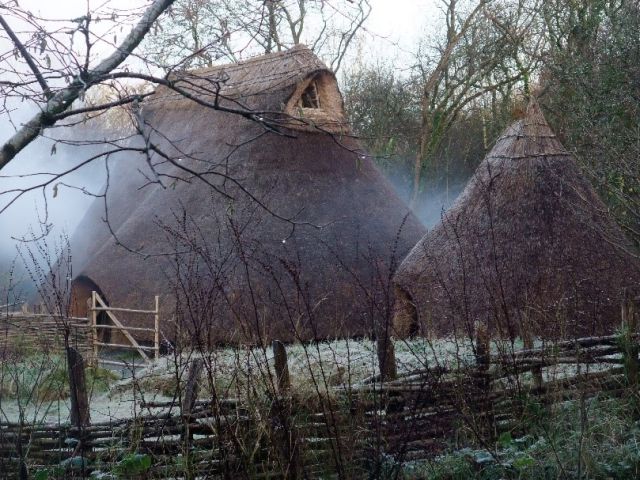Ireland’s population underwent a dramatic change 4,000 years ago

Ireland’s population underwent a dramatic change 4,000 years ago -- original article
by Annalee Newitz -- Ars Technica
----------------------------------------------------
Ancient DNA offers a glimpse of Ireland's farmers before and after the shift.

Recreation of an Irish Neolithic village, similar to the one where the Ballynahatty woman lived 5,000 years ago.
Farming began in the West roughly 10,000 years ago, with Neolithic villagers slowly domesticating grains in the regions that today we call Turkey, Syria, and Iraq. Just a few thousand years later, it had spread throughout Europe. But how did it get there, and who brought it? A new study of ancient DNA from Irish settlers between 5,000 and 3,000 years ago helps to tell this story.
Trinity College geneticist Lara Cassidy and her colleagues describe their work in an article out today from Proceedings of the National Academy of Science . They sequenced the genomes of four ancient Irish people: a Neolithic woman who was buried in a megalithic tunnel grave about 5,000 years ago in Ballynahatty (see video below for what a megalithic grave looks like) and three Bronze Age men discovered in an underground "cist" grave on Rathlin Island from about 4,000 years ago.
A flythrough of the Dowth megalithic tomb in Ireland, created from detailed laser scans, shows the kind of grave where the Neolithic Ballynahatty woman was buried.
The differences between the Ballynahatty woman and the Rathlin men are dramatic—during the millennium that separated their lives, it's likely that Irish people and culture underwent a major upheaval. The Ballynahatty woman likely had dark hair and eyes, with distant kin from the Near East, where western agriculture was born. She also shared genetic similarities with people from the region now known as Spain, which suggests that her ancestors took a southerly route along the coast as they migrated from the Near East to Ireland. The Neolithic peoples of Spain also buried their dead in megalithic tunnel graves, which suggests a cultural continuity between the Ballynahatty woman's people and her ancestors.
Ireland and the rest of Europe went through momentous changes in the centuries after the Ballynahatty woman died. By the time the Rathlin men were buried, the Irish population had been transformed by many waves of immigration. The Rathlin men were likely blue-eyed, and their kin hailed from a region called the Pontic Steppe above the Black Sea in Central Europe. They also came from farmer stock, and like many other western agricultural people they had a genetic mutation called "lactase persistence" which allowed them to eat milk products as adults without getting sick. By contrast, the Ballynahatty woman was more closely related to groups of hunter-gatherers.
Cassidy and her colleagues suggest that these genetic changes would likely have come with cultural shifts, as the people of the Pontic Steppe brought new languages, farming techniques, and metallurgy to Ireland. It was "perhaps the first introduction of the Indo-European language ancestral to the Irish," they write. In addition, the Rathlin men's group was very similar to Irish people today. One of the men even suffered from a genetic mutation that causes the blood disease hemochromatosis, an ailment that remains common among Celtic people. "These findings together suggest the establishment of central attributes of the Irish genome 4,000 years ago," write the researchers. Daniel Bradley, who designed the research project, told The Washington Post that it was a "surprise" to see so much in common between the ancient Irish genome and the modern one.
Harvard Medical School population geneticist Pontus Skoglund , who was not involved in the study, praised the research as "great." He told Ars via e-mail that it fit with what he and other researchers have already found in examining ancient genomes elsewhere in Europe, especially when it came to the massive waves of migration between 5,000 and 4,000 years ago. "The first farmers did not likely come from the Pontic Steppe (they came ultimately from the Near East and Anatolia), but later Bronze Age people did," he said. "This paper is in agreement with this model, [and] there is evidence that it is true for most parts of Europe now. This paper is a wonderful addition in providing the first genomes of early farmers in Britain."
Of course, this is only part of the story, because agriculture spread through Asia and the Americas via different paths. But what the western story shares with the eastern one is evidence of brave immigrants who traveled far from home just so they could find a place to settle down, the way many humans still do today.
Tags
Who is online
83 visitors

This is interesting, opposite Kavika's articles on North American excavations.
Back in the day, apparently things were pretty similar...
It certainly seems so Bob.
These types of articles are very interesting.
I just found one on the study of the Polynesia people and their origins.
Very interesting and educational. I really enjoyed the video! Thanks for posting this!!